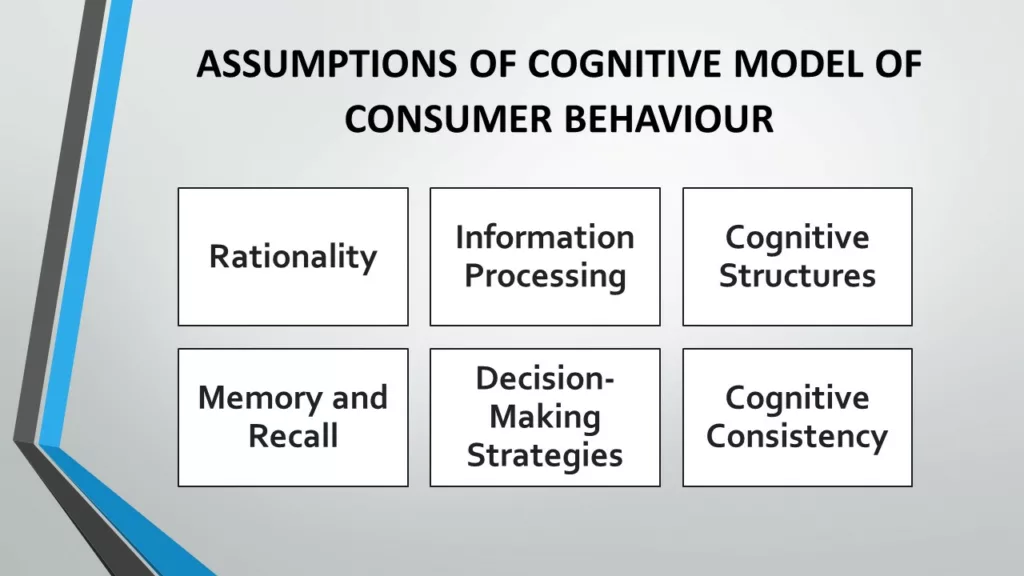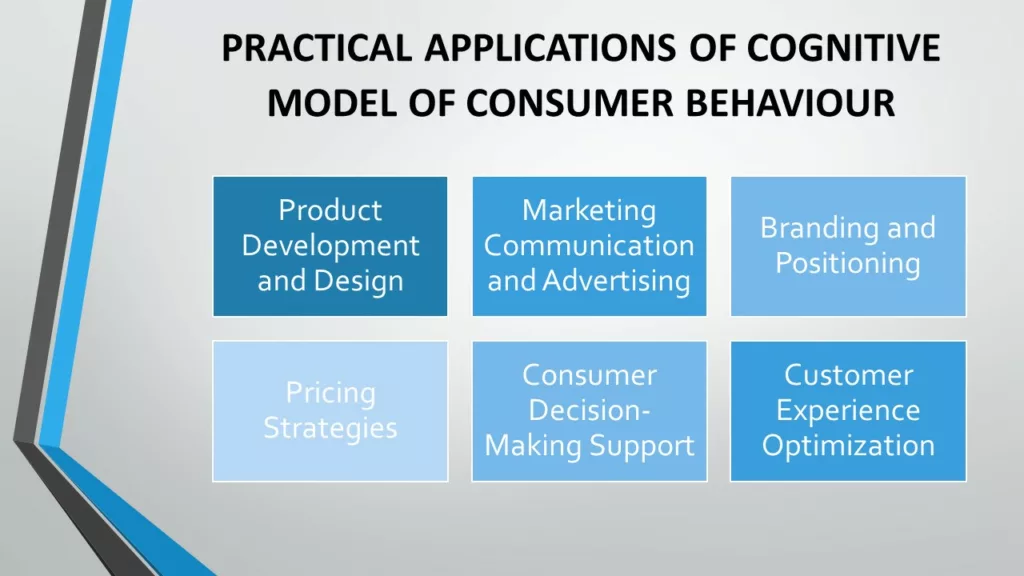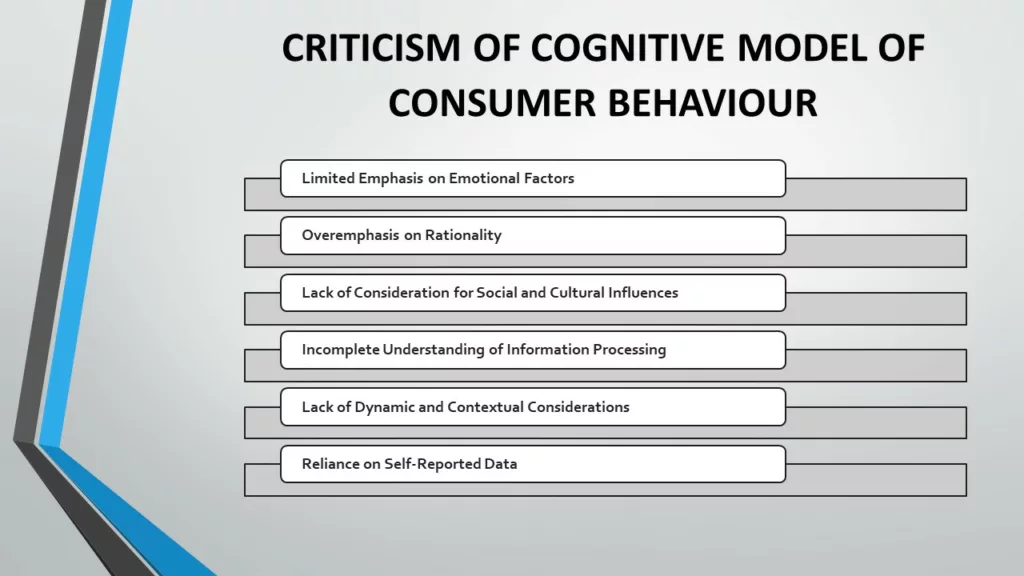COGNITIVE MODEL OF CONSUMER BEHAVIOUR
The cognitive model of consumer behavior is a psychological framework that focuses on the mental processes and cognitive factors that influence consumer decision-making. It emphasizes the role of information processing, memory, beliefs, attitudes, and decision-making strategies in shaping consumer behavior. The cognitive model recognizes that consumers are active processors of information, who engage in cognitive activities to evaluate alternatives and make choices.
COMPONENTS OF COGNITIVE MODEL OF CONSUMER BEHAVIOUR
Here are the key components of the cognitive model of consumer behavior:

- Information Processing: The cognitive model emphasizes how consumers acquire, interpret, and utilize information in their decision-making process. It highlights the stages of information processing, such as attention, perception, comprehension, and memory, and their impact on consumer behavior. Consumers selectively attend to relevant information, interpret it based on their existing knowledge and beliefs, comprehend its meaning, and store it in memory for future use.
- Cognitive Structures: Cognitive structures refer to the mental frameworks or schemas that consumers develop to organize and interpret information. These structures consist of beliefs, attitudes, values, and expectations that guide consumer decision-making. Cognitive structures help consumers simplify complex information and make decisions more efficiently. They also influence how consumers perceive and evaluate products, brands, and marketing messages.
- Decision-Making Processes: The cognitive model examines the cognitive processes involved in consumer decision-making. It recognizes that consumers engage in systematic evaluation and comparison of alternatives to make choices. Consumers may employ different decision-making strategies, such as compensatory decision-making (weighing the pros and cons of each alternative) or non-compensatory decision-making (using specific decision rules to eliminate options). These processes involve mental calculations, trade-offs, and evaluations based on cognitive structures and information processing.
- Memory and Retrieval: Memory plays a vital role in the cognitive model of consumer behavior. Consumers rely on their memory to retrieve stored information when evaluating alternatives and making decisions. This includes retrieving information about product features, past experiences, brand associations, and other relevant knowledge. Memory influences consumer judgments, preferences, and purchase decisions.
- Beliefs and Attitudes: The cognitive model recognizes that consumers’ beliefs and attitudes significantly influence their behavior. Beliefs are consumers’ subjective perceptions of the attributes and characteristics of products or brands, while attitudes reflect their overall evaluation and emotional response towards them. Beliefs and attitudes are formed based on personal experiences, social influences, and information processing, and they shape consumer preferences and purchase intentions.
- Decision-Making Heuristics: The cognitive model acknowledges that consumers often rely on mental shortcuts or decision-making heuristics to simplify complex decisions. Heuristics are mental rules of thumb that guide decision-making and help consumers make judgments and choices more efficiently. Examples of heuristics include price-quality heuristics (assuming higher-priced products are of higher quality) or brand loyalty heuristics (choosing familiar brands to reduce decision complexity).
The cognitive model of consumer behavior provides insights into the cognitive processes, mental structures, and decision-making strategies that influence consumer choices. It highlights the importance of information processing, memory, beliefs, attitudes, and decision-making heuristics in understanding consumer behavior. Marketers can leverage this model to design effective communication strategies, shape brand perceptions, and tailor product offerings to align with consumers’ cognitive processes and decision-making strategies.
ASSUMPTIONS OF COGNITIVE MODEL OF CONSUMER BEHAVIOUR
The cognitive model of consumer behavior is built upon several key assumptions that provide the foundation for understanding how consumers process information and make decisions. These assumptions help explain the cognitive processes and mental structures involved in consumer behavior. Here are some of the main assumptions of the cognitive model of consumer behavior:

- Rationality: The cognitive model assumes that consumers are rational decision-makers who aim to maximize their utility or satisfaction. It assumes that consumers evaluate alternatives and make choices based on logical reasoning and systematic information processing. However, it is important to note that this assumption has been criticized in behavioral economics, as consumers may exhibit biases and rely on heuristics that deviate from strict rationality.
- Information Processing: The model assumes that consumers actively process and interpret information about products, brands, and marketing messages. Consumers selectively attend to relevant information, encode it into memory, and retrieve it when making decisions. Information processing involves cognitive activities such as attention, perception, comprehension, categorization, and evaluation.
- Cognitive Structures: The cognitive model assumes that consumers possess cognitive structures, such as beliefs, attitudes, values, and expectations, that guide their decision-making. These cognitive structures serve as mental frameworks or schemas that help consumers organize and interpret information. They influence how consumers perceive, evaluate, and make judgments about products and brands.
- Memory and Recall: The model assumes that consumers store and retrieve information from memory when making decisions. Consumers draw upon their past experiences, knowledge, and stored information to evaluate alternatives and make choices. Memory retrieval influences consumer judgments, preferences, and purchase decisions. However, the accuracy and reliability of memory recall can be influenced by various factors, such as biases and memory distortions.
- Decision-Making Strategies: The cognitive model recognizes that consumers employ different decision-making strategies when evaluating alternatives. Consumers may engage in systematic, information-based decision-making, weighing the pros and cons of each option. They may also use decision-making heuristics, which are mental shortcuts or rules of thumb, to simplify complex decisions. The model assumes that consumers choose the decision-making strategy that best suits their cognitive capacity and the decision context.
- Cognitive Consistency: The cognitive model assumes that consumers strive for cognitive consistency in their decision-making. Consumers seek coherence and alignment between their beliefs, attitudes, and behaviors. They are motivated to reduce cognitive dissonance, which arises when there is inconsistency between their beliefs or attitudes and their actual choices. Consumers may adjust their beliefs or attitudes to achieve cognitive consistency.
These assumptions provide a basis for understanding the cognitive processes and mental structures that underlie consumer decision-making. While these assumptions provide valuable insights, it is important to recognize that consumer behavior is influenced by various other factors, such as emotions, social influences, and situational contexts, which may interact with cognitive processes in complex ways.
IMPORTANCE OF COGNITIVE MODEL OF CONSUMER BEHAVIOUR
The cognitive model of consumer behavior holds significant importance in understanding and predicting consumer behavior. Here are some key reasons why the cognitive model is valuable:

- Insights into Decision-Making Processes: The cognitive model provides insights into the cognitive processes involved in consumer decision-making. It helps marketers understand how consumers gather, process, and evaluate information, as well as how they make choices among competing alternatives. By understanding these processes, marketers can design communication strategies, product features, and pricing schemes that align with consumers’ cognitive processes, improving the effectiveness of their marketing efforts.
- Understanding Consumer Perceptions and Interpretations: The cognitive model emphasizes the role of perception and interpretation in consumer behavior. It helps marketers comprehend how consumers perceive and interpret marketing messages, product attributes, and brand information. By understanding how consumers construct their mental representations of products and brands, marketers can design more targeted and persuasive communication strategies that align with consumers’ perceptions and interpretations.
- Predicting and Influencing Consumer Attitudes and Beliefs: The cognitive model allows for the prediction and influence of consumer attitudes and beliefs. Marketers can utilize the model to understand how consumers form their beliefs and attitudes about products and brands. By influencing the information consumers attend to, the way it is presented, and the associations they form, marketers can shape consumer attitudes and beliefs, ultimately influencing consumer behavior and purchase decisions.
- Tailoring Marketing Strategies and Communication: The cognitive model provides guidance for tailoring marketing strategies and communication efforts to consumers’ cognitive processes. By understanding how consumers encode, store, and retrieve information, marketers can design marketing materials that are more likely to be attended to, remembered, and retrieved from memory. This knowledge allows marketers to optimize advertising, packaging, and promotional efforts to align with consumers’ cognitive abilities and preferences.
- Insights into Memory and Recall Processes: The cognitive model sheds light on how consumers store and retrieve information from memory. Understanding memory processes helps marketers optimize brand positioning and recall. By designing marketing materials that facilitate encoding, storage, and retrieval from memory, marketers can increase the likelihood of consumers recalling their brand when making purchase decisions, thereby increasing brand preference and loyalty.
- Identifying and Overcoming Cognitive Biases: The cognitive model helps identify cognitive biases that may affect consumer decision-making. By understanding these biases, marketers can design strategies to overcome them. For example, marketers can provide clear and salient information, use comparative advertising, or leverage social proof to address biases such as confirmation bias, availability bias, or social influence. This enables marketers to mitigate the impact of biases and improve decision-making outcomes.
In summary, the cognitive model of consumer behavior provides valuable insights into the cognitive processes, perceptions, interpretations, and decision-making strategies that shape consumer behavior. By leveraging this understanding, marketers can design effective marketing strategies, tailor communication efforts, influence consumer attitudes and beliefs, and optimize brand positioning to better meet consumers’ needs and preferences.
PRACTICAL APPLICATIONS OF COGNITIVE MODEL OF CONSUMER BEHAVIOUR
The cognitive model of consumer behavior has several practical applications across various marketing contexts. Here are some practical applications of the cognitive model:

- Product Development and Design: Understanding consumers’ cognitive processes can help inform product development and design. By analyzing consumers’ needs, preferences, and cognitive structures, marketers can create products that align with consumers’ mental representations and expectations. This includes factors such as product features, packaging design, user interfaces, and usability, all of which can be tailored to enhance consumers’ cognitive experiences and facilitate decision-making.
- Marketing Communication and Advertising: The cognitive model can guide the development of effective marketing communication strategies. By understanding how consumers process and interpret information, marketers can create compelling messages that capture consumers’ attention, resonate with their cognitive structures, and facilitate information processing. This includes using attention-grabbing visuals, clear and concise messaging, and appealing to consumers’ beliefs and attitudes to enhance message recall and persuasion.
- Branding and Positioning: The cognitive model helps marketers understand how consumers perceive and categorize brands. By leveraging consumers’ cognitive structures and associations, marketers can position their brands in a way that aligns with consumers’ mental frameworks. This involves creating unique brand attributes, leveraging brand imagery, and developing associations that are consistent with consumers’ beliefs and attitudes.
- Pricing Strategies: The cognitive model can inform pricing strategies by considering consumers’ cognitive processes related to price perception and evaluation. Marketers can utilize cognitive biases such as reference pricing, decoy pricing, and anchoring to influence consumers’ price perceptions and increase their willingness to pay. By understanding how consumers encode and process price information, marketers can optimize pricing strategies to align with consumers’ cognitive expectations.
- Consumer Decision-Making Support: The cognitive model can be used to develop decision-making aids and tools that assist consumers in making informed choices. By providing clear and relevant information, comparisons, and decision-making frameworks, marketers can support consumers’ cognitive processes and facilitate their decision-making. This includes tools such as product comparison charts, interactive decision support systems, and online configurators that help consumers navigate complex purchase decisions.
- Customer Experience Optimization: Understanding consumers’ cognitive processes allows marketers to optimize the overall customer experience. By mapping out consumers’ cognitive journey and identifying pain points, marketers can design experiences that reduce cognitive load, enhance information processing, and provide a seamless and enjoyable customer experience. This includes streamlining the purchase process, providing relevant information at critical touchpoints, and ensuring consistency across different channels.
These practical applications demonstrate how the cognitive model of consumer behavior can be used to inform marketing strategies, product development, pricing decisions, and customer experiences. By understanding and leveraging consumers’ cognitive processes, marketers can better meet consumers’ needs, enhance decision-making outcomes, and build stronger relationships with their target audience.
CRITICISM OF COGNITIVE MODEL OF CONSUMER BEHAVIOUR
While the cognitive model of consumer behavior has been widely used and valued, it has also faced criticism from various perspectives. Here are some common criticisms of the cognitive model:

- Limited Emphasis on Emotional Factors: One criticism of the cognitive model is its limited emphasis on the role of emotions in consumer behavior. Emotions play a crucial role in decision-making and can significantly impact consumer preferences and choices. Critics argue that the cognitive model fails to adequately incorporate emotional factors into its framework, leading to an incomplete understanding of consumer behavior.
- Overemphasis on Rationality: The cognitive model assumes that consumers are rational decision-makers who carefully process information and make logical choices. However, research in behavioral economics and psychology has shown that consumers often deviate from strict rationality and are influenced by biases, heuristics, and emotions. Critics argue that the cognitive model’s assumption of rationality oversimplifies consumer decision-making and does not account for the complexities of human behavior.
- Lack of Consideration for Social and Cultural Influences: The cognitive model tends to focus on individual cognitive processes and overlooks the significant impact of social and cultural factors on consumer behavior. Consumers are influenced by social norms, cultural values, peer pressure, and social interactions, which can shape their beliefs, attitudes, and decision-making. Critics argue that neglecting these influences limits the explanatory power of the cognitive model.
- Incomplete Understanding of Information Processing: The cognitive model assumes a linear and sequential information processing framework, where consumers systematically gather, process, and evaluate information. However, research has shown that consumers often employ shortcuts, biases, and heuristics to simplify decision-making. Critics argue that the model’s emphasis on systematic information processing may not accurately reflect how consumers actually make choices in real-world settings.
- Lack of Dynamic and Contextual Considerations: The cognitive model often treats consumer behavior as a static and isolated process, neglecting the dynamic and contextual nature of consumer decision-making. Consumers’ choices are influenced by situational factors, temporal influences, and changing circumstances. Critics argue that the cognitive model should incorporate a more dynamic and context-dependent perspective to capture the complexities of consumer behavior.
- Reliance on Self-Reported Data: The cognitive model often relies on self-reported data obtained through surveys or interviews, which may be subject to biases and inaccuracies. Consumers’ self-perceptions and reported decision-making processes may not always align with their actual behaviors. Critics argue that this reliance on self-reported data may introduce limitations and potential biases in the findings derived from the cognitive model.
It is important to note that these criticisms do not discount the value of the cognitive model entirely. Instead, they highlight areas where the model may fall short in capturing the full complexity of consumer behavior. Integrating insights from other models, such as affective models and sociocultural frameworks, can help provide a more comprehensive understanding of consumer behavior.